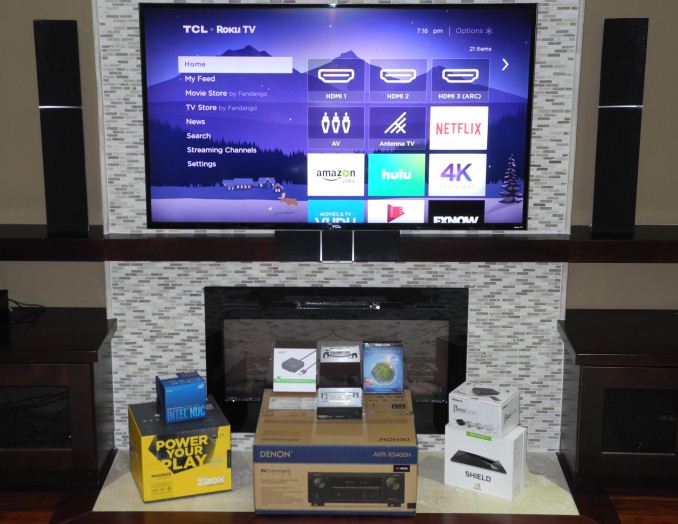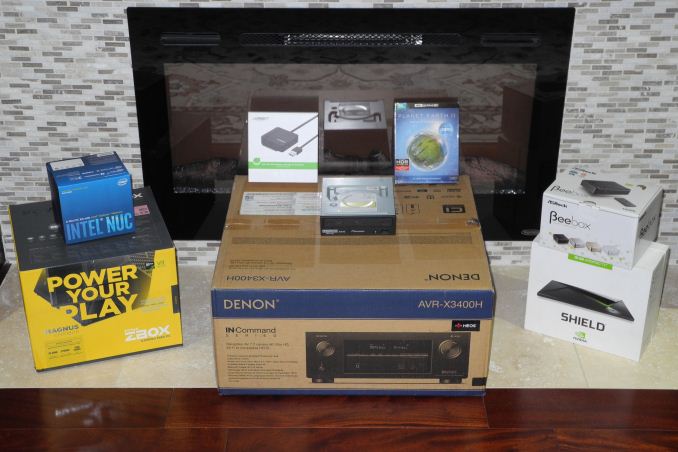A Budget Home Theater & PC Setup: 4K, HDR, UHD Blu-ray, and More
by Ganesh T S on December 26, 2017 8:30 AM EST
The days of bulky HTPCs with built-in optical drives, massive internal storage arrays, and integrated TV tuners are long gone. The advent of over the top (OTT) online streaming services has moved a lot of functionality to the cloud. As NAS units become more powerful, it has made sense to move local media files to a central repository. All these have enabled the TV-connected PC to become more compact. Unless the consumer has specific requirements (like, say, high quality gaming), even ultra-compact form factor (UCFF) machines such as the Intel NUCs can fit the bill.
Home Theater Components: Keeping up with the Times
The primary functionality of HTPCs has evolved to become one of a powerful and versatile media player. However, recent advances such as 4K and high dynamic range (HDR) videos, as well as stricter DRM requirements such as HDCP 2.2 for premium content have made the perfect HTPC platform difficult to achieve. Before delving deeper into these new advances, it is helpful to have some insight into how the landscape has changed over the last decade or so. The advancements in that timeframe have meant that next attractive home theater feature was always around the corner. In the initial days of 720p televisions and other home theater equipment, it was Full HD (1080p). As 1080p became widespread, it was HD audio bitstreaming. After that, 3D support was sought after. A brief lull ensued before the market started slowly getting ready for 4K.
Over the last year or so, we have seen the appearance of displays and audio/video receivers (AVRs) supporting HDMI 2.0 / HDCP 2.2 along with HDR / Dolby Vision. Despite the announcement of HDMI 2.1, I believe that we have reached a point where it is possible to purchase a relatively inexpensive home theater and HTPC configuration without worrying about it getting obsolete within the the next 3 to 5 years.
On the media side, OTT streaming services have become popular to the extent that Netflix and YouTube moved to offer 4K videos to consumers ahead of Blu-rays. Fortunately, many modern PCs are capable of 4K Netflix playback, though HDR is available only on a subset of those configurations. UHD Blu-ray playback support is available through CyberLink PowerDVD 17. However, the hardware requirements are a lot more specific compared to premium OTT services. UHD Blu-ray playback with HDR requires that the home theater components fulfill additional requirements.
Building a Home Theater on a Budget
I started work on this home theater piece back in June 2017. The aim was to present a setup (TV, AVR, and HTPC) with all the bells and whistles, yet light on the wallet. While the TV (TCL 55P607) and the AVR (Denon AVR X3400H) were easy to narrow down based on the feature requirements and budget, the PC side proved to be more challenging. Our core requirements (compact form factor, 4K Netflix support, and HDR capability) narrowed down the choices to a NVIDIA Pascal GPU-equipped PC or a Kaby Lake PC with HDCP 2.2 capabilities. UHD Blu-ray support further narrowed this down to certain Kaby Lake PCs with a HDMI 2.0 / HDCP 2.2 display output.
In the course of our evaluation, we found that consumer electronic (CE) equipment almost always received features ahead of HTPC platforms. Keeping this in mind, we ended up evaluating a number of options for the fulfillment of HTPC duties
- Roku Smart TV platform in the TCL 55P607
- NVIDIA SHIELD Android TV (SATV)
- Zotac ZBOX MAGNUS EN1080K
- ASRock Beebox-S 7200U
- Intel NUC7i7BNHX
Prior to looking at the performance of these options, it will be of interest to readers to delve deeper into our choice for the other home theater components. Earlier this year, I happened to embark on a house remodel, and I took that opportunity to revamp the HTPC test components used in our system reviews. Our choice of components is geared towards a typical family room (15' x 15') home theater.











191 Comments
View All Comments
pjcamp - Wednesday, December 27, 2017 - link
The one thing you didn't mention is what keyboard you are using. I haven't been happy with any of the ones I've used so a little help would be, well, helpful.DIE_BETA_SOY_BOYS - Wednesday, December 27, 2017 - link
"budget"What a useless article
watersb - Wednesday, December 27, 2017 - link
I, for one, enjoyed this write-up very much. I have been out of the AV Zone for a decade, but as a musician and PC enthusiast I was curious to see how this played out.A write-up like this: I have done similar tests for audio-only gear, and it took 50 hours of work. Maybe I'm too slow.
And finally, this may be a dumb question, but for a Home Theater setup, what keyboard/pointing device work best for you? I need to get something. My ten-year-old Gyration Mouse/keyboard has died. Not kidding. It was great. Backlit keyboard that can see duty as primary PC keyboard preferred.
What are you all using?
Shaan1969 - Thursday, December 28, 2017 - link
watersb, Logitech K830 (~$50) is the best one with long lasting rechargeable battery with back-lit option. I have been using it for the last few years without any issues.watersb - Tuesday, January 2, 2018 - link
Thanks! Was on my list, at $50 the price has come down a bit since last I looked.Shaan1969 - Thursday, December 28, 2017 - link
Ganesh, thank you for taking time to write up a great article. I thoroughly enjoyed reading it and planning to upgrade my HTPC accordingly this weekend.Everyone's definition of budget is different and I wish readers focus on the content of the article rather than accusing the writer.
milkod2001 - Thursday, December 28, 2017 - link
good read, you might want to also upgrade those curtains granny bought and insisted to use when on last visit while you are in this upgrading process.UtilityMax - Friday, December 29, 2017 - link
This situation with the high cost and pain-in-the-butt involved in 4K HTPC setup compared to buying Playstation 4, Xbox, or Roku reminds me of a similar situation that happened with home routers in the late 1990s. As the Internet connections started becoming more affordable (be it dialup or broadband) a whole lot of geeks wanted to come up with solutions so that their entire home network could connect to the internet with just one IP address. A whole lot of them turned to setting up a dedicated PC running Linux to act as their gateway to the internet for the purpose of firewalling and network address translation (NAT). This made even people originally not interested in using Linux start exploring the Linux systems because back in the 1990s Linux distributions were way better than Windows or Macs at advanced networking stuff.Then an interesting thing happened. A cheap Taiwanese-made router with firewall, NAT, and a 4-5 port 100Mbps switch became available for something like 50 bucks around year 1999-2000. This has near instantly killed the concept of setting up manually a dedicated PC to act as your router gateway. Today you don't even have to buy a dedicated router, because your broadband cable modem probably already comes integrated with wifi, router, NAT, firewall, switch, and all that (mine does).
The same way we are observing the situation where various set top boxes or "sticks" costing under a couple of hundred bucks, gaming consoles, and even smart TVs have pretty much near eliminated the whole point of building a dedicated HTPC. HTPC is basically a dinosaur.
Combine that with the fact that most people out there still don't give a damn about 4K content, don't have 4K TVs, don't have access to 4K cable (duh!), and don't want to pay for either 4K BD discs or for high speed internet conections required for 4K streaming, and you see why building your own HTPC is going to be just like banging your head against a wall.
rapster - Friday, December 29, 2017 - link
Totally agree. The NVIDIA Shield has - for me - made the PC moot. This time around I based my system on a Shield that streams from the internet and Synology disk array, a “budget” receiver, a BD player, some great speakers, and an old 1080p TV. Not even sure what use a PC would serve.mikato - Thursday, January 18, 2018 - link
Sounds good. I’ll have to check out the Shield. But you can’t bring this to a friend’s house and plug into their TV or home theater. I want that too :)